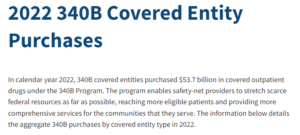The federal government recently released information on the total purchases that hospitals, health centers, and clinics made through the 340B drug pricing program in 2022. The Health Resources & Services Administration (HRSA) reported that these purchases reached $53.7 billion, meaning 340B covered entities spent $9.8 billion more on 340B drugs than they did in 2021. This release provided an opportunity to take a closer look at why that figure increased.
Putting 340B Purchases in Perspective
In addition to understanding the drivers behind the 340B purchase figures, it is important to understand what the HRSA totals mean. The purchase totals pertain to the tens of billions of dollars that drug companies take into their coffers for selling 340B-eligible drugs. They do not quantify how much hospitals received in savings for those discounted drugs, as implied by some drug industry critics of 340B.
It is not at all a given that an increase in the amount of 340B purchases translates into a corresponding increase in 340B savings. The 340B value depends on both the price of each drug and the 340B discount for that drug. These are factors that hinge on whether a drug is brand-name or generic, how the drugmaker has hiked prices over time, and what drug discounts the company has offered other payers.
With the understanding of how 340B purchases differ from discounts, one can turn to the key reasons why drugmakers are selling more of these drugs each year.
A Continued Shift Toward Outpatient Care
A major element behind total 340B drug purchases has nothing to do with how hospitals use 340B. Instead, it reflects a continued shift away from providing hospital care in the inpatient setting.
In recent years, hospital outpatient revenue exceeded inpatient revenue for the first time. This was the latest development in a trend that accelerated during the COVID-19 pandemic.
Other research notes that the shift toward outpatient care – and the use of 340B-eliglble drugs that go along with it – are due to several key reasons. They include advances in outpatient care and technology, changes in reimbursement for care, and patient preferences.
High Prices for New Drugs
Other big drivers of 340B purchases are the often-astronomical prices that drugmakers set for new products that they are bringing to market. High prices are an issue because the 340B discount for new brand-name drugs is 23.1%, meaning hospitals are paying more than three-quarters of those starting prices. Drugs that have been on the market for years and have undergone large price hikes have deeper 340B discounts.
A recent study found that net launch prices for new drugs skyrocketed from a median of $1,376 in 2008 to $159,042 in 2021. Recent launch prices for individual drugs have been so high in several cases that they have generated nationwide media coverage.
Many of these new products are drugs that are infused or injected in the hospital outpatient setting, which make them 340B-eligible for hospitals that qualify. That contributes to total 340B purchases beyond any additional uptake of drugs that have been on the market for years.
The Rise of Specialty Drugs
Increasing numbers of patients are being prescribed specialty drugs to treat their diseases and conditions. These drugs often come with special handling requirements and more complex instructions. They also often come with very high price tags.
Those high price tags have helped drive 340B drug spending because the mix of drugs that providers prescribe is rapidly shifting toward specialty drugs. These include some of the costliest products to treat cancer, multiple sclerosis, autoimmune disorders, and other complex diseases.
When 340B first came into being in 1992, virtually no specialty drugs existed. Data show that by 2010 they made up 27% of pharmaceutical spending, and by 2022 that figure was a whopping 51%. In the decade from 2012 to 2022, spending on specialty drugs grew from $81 billion to $219 billion.
Massive uptake in the use of just a few blockbuster drugs can move the needle rapidly on the amount spent on 340B drugs. 340B Health calculations of pricing data demonstrate that just five specialty drugs introduced within the past decade (Keytruda, Darzalex, Dupixent, Biktarvey, and Trikafta) alone accounted for a $2.3 billion increase in 340B purchases from 2019 to 2020.
